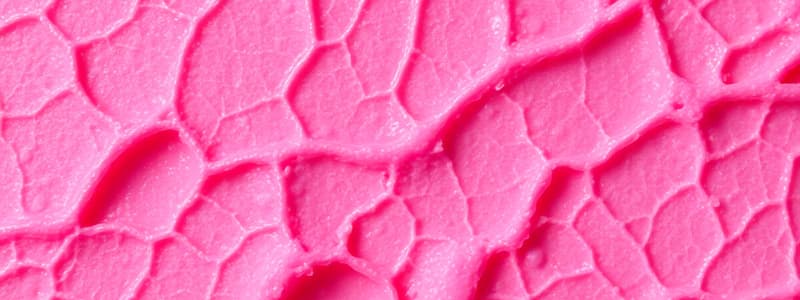Podcast
Questions and Answers
What are the main cells involved in the synthesis and storage of triglycerides in adipose tissue?
What are the main cells involved in the synthesis and storage of triglycerides in adipose tissue?
- Fibroblasts
- Chondrocytes
- Adipocytes (correct)
- Osteocytes
Which hormone does NOT influence the formation or release of fat from white adipocytes?
Which hormone does NOT influence the formation or release of fat from white adipocytes?
- Noradrenaline
- Insulin
- Glucagon (correct)
- Growth hormone
What is a key characteristic of brown adipose tissue?
What is a key characteristic of brown adipose tissue?
- Presence of large fat droplets
- Predominantly found in adults
- Thick extracellular matrix
- High concentration of mitochondria (correct)
Which type of adipose tissue is primarily involved in energy reserve?
Which type of adipose tissue is primarily involved in energy reserve?
Which of the following cells are NOT commonly found in white adipose tissue?
Which of the following cells are NOT commonly found in white adipose tissue?
What is the primary role of brown adipose tissue in hibernating animals?
What is the primary role of brown adipose tissue in hibernating animals?
In what locations is white adipose tissue predominantly found?
In what locations is white adipose tissue predominantly found?
What distinguishes a white adipocyte's structure?
What distinguishes a white adipocyte's structure?
Flashcards
Adipose Tissue
Adipose Tissue
A specialized connective tissue that stores fat. It is composed mainly of adipocytes, which are derived from mesenchymal cells and synthesize and store triglycerides.
White Adipose Tissue
White Adipose Tissue
A type of adipose tissue characterized by large, spherical cells with a single large fat droplet that displaces the nucleus to the periphery. It plays a crucial role in energy storage, thermal insulation, and organ support.
Brown Adipose Tissue
Brown Adipose Tissue
A type of adipose tissue characterized by smaller, polygonal cells with multiple small fat droplets. It is abundant in mitochondria and plays a key role in thermogenesis, particularly in newborns and hibernating animals.
Adipocytes
Adipocytes
Signup and view all the flashcards
Fat Deposition
Fat Deposition
Signup and view all the flashcards
Fat Usage
Fat Usage
Signup and view all the flashcards
Hormonal Control of Fat Metabolism
Hormonal Control of Fat Metabolism
Signup and view all the flashcards
Nervous and Hormonal Control of Fat Metabolism
Nervous and Hormonal Control of Fat Metabolism
Signup and view all the flashcards
Study Notes
Specialized Connective Tissue
- Specialized connective tissues include fibrous, adipose, cartilage, and bone tissues.
- These tissues all have unique compositions and functions.
Fibrous Connective Tissue
- Fibrous connective tissue, such as tendons, is made of collagen fibers.
- It also includes elastic fibers that provide flexibility and strength.
Adipose Tissue
- Adipose tissue, or fat, is specialized connective tissue that stores fat.
- The main cells are adipocytes, derived from mesenchymal cells.
- Adipocytes participate in triglyceride synthesis and storage.
Types of Adipose Tissue
- White adipose tissue (unilocular): Large, spherical cells with a single fat droplet that displaces the nucleus to the periphery.
- Brown adipose tissue (multilocular):Smaller, more polygonal cells with multiple fat droplets. They have numerous mitochondria.
White Adipose Tissue
- Composed mainly of white adipocytes.
- Also has macrophages, mast cells, fibroblasts, and lymphocytes.
- Has scarce extracellular matrix (ECM).
- Abundant vascularization and innervation.
- Found in subcutaneous tissue; amount varies by sex and age.
- Functions include mechanical protection, thermal insulation, organ support, and energy reserve.
Brown Adipose Tissue
- Composed mainly of brown adipocytes.
- Also has adipoblasts (preadipocytes), macrophages, mast cells, fibroblasts, and lymphocytes.
- Has scarce ECM and fibers.
- Abundant vascularization and innervation.
- Primarily found in newborns and hibernators, with limited presence around major blood vessels in adults.
- Essential for maintaining body temperature due to abundant mitochondria.
Cartilage
- Cartilage is a specialized connective tissue that forms the ends of bones and other supportive structures.
- It's composed of cartilage-forming cells and a matrix.
Bone
- Bone is a supportive connective tissue.
- It consists of bone-forming cells, a matrix, and a central canal.
- Bone comes in compact and spongy forms.
Blood
- Blood is a fluid connective tissue.
- It contains plasma and various blood cells (red and white blood cells).
Connective Tissue Classification
- Connective tissues are classified into proper, supportive, and fluid connective tissues.
- Proper connective tissue encompasses loose and dense types.
- Supportive connective tissues include cartilage and bone.
- Fluid connective tissue, such as blood, is a specialized type.
Studying That Suits You
Use AI to generate personalized quizzes and flashcards to suit your learning preferences.




